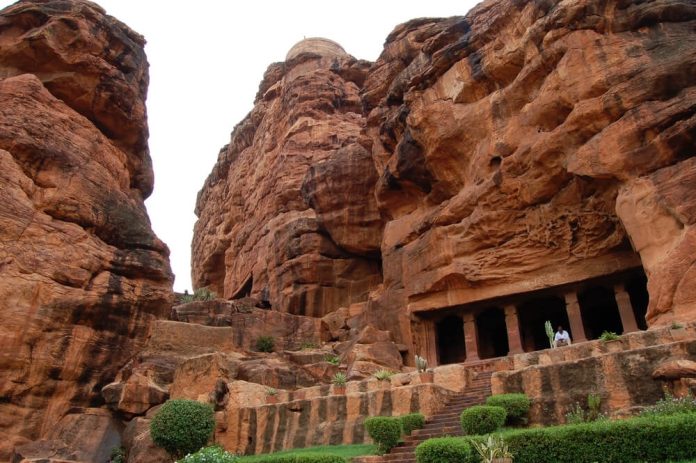
Have you ever wondered what it would have been like to live in a time when buildings were an expression of a civilisation, uncorrupted by cultural confusions, globalisation or hyper connectivity? Yes, I am talking about a pure kind of ancient architecture, from as early as the 5th century BC. On a warm October morning we set out to visit Badami, a small town in Northern Karnataka, that along with the neighbouring villages of Aihole and Patadakkal has been dubbed as the ‘cradle of temple architecture’. Lying in modern day Baghakhot district, these localities apparently still carry on at a pace oblivious to the events that shaped the modern world.

Set in a serene backdrop of rolling greenery and red rock formations there is no hustle bustle in Badami except for the tourist inflow, which is also gentle and moderate. While UNESCO sites, Badami, Aihole or Pattadakkal have not been marketed like say the Taj or a European contemporary. Perhaps this anonymity or lack of popularity is what preserves the sanctity of the place as it should be. Perhaps it is also this quality of isolation that makes a marked impression in the mind of the visitor; one of a meditative, blissful variety to which one wants to return time and again. There is no place for helpless modern day indulgences such as meaningless browsing or continuous whatsapping when you are in the lap of nature and beauty.

Since the sites are dotted with temples, one soon loses track of the names and specific history of each structure here. The most memorable structures to be called out however are the Bhoothanath group of temples dedicated to Lord shiva, and the Badami caves. Yet another architectural gem of unique taste is the tomb of Ibrahim Rouza, located in Vijayapura, about 2.5 hours by car from Badami. We took the trouble to go down as the locals referred to the tomb as the Black Taj, and informed us that the architectural design of the Taj Mahal was in fact inspired by this tomb. True to hearsay we were astounded by the grace, fineness of detail and poise of Islamic Architecture in all its splendour.
The group of temples located in all three destinations, namely the town of Badami and the villages of Aihole and Pattadakkal are the contribution of the Eastern Chalukyan dynasty(6th to 8th century CE). Bound by the Narmada and Kaveri rivers, these three sites were culturally diverse across the vast areas covered. The ruling Chalukyan dynasties were patrons of cultural expressions especially focussed on temple and cave art and architecture. The temples at Aihole, Badami and Pattadakal are the largest, earliest group of monuments which comprehensively demonstrates the evolution in Hindu rock-cut and temple architecture in India. At the ‘cradle of Temple Architecture’, experimentation defined the components of a typical Hindu Temple.
At ‘Badami caves’, once can see four rock-cut caves adorned with ancient carved pillars and figures cut out of red sandstone. The caves overlook the Agastya Theertha Lake, its banks dotted with the group of Bhutanatha Temples.

The first Badami cave temple is dedicated to Nataraja (Lord Shiva). A life-size 18 handed Nataraja image striking dance poses welcomes the visitors here. The second cave temple is flanked by celestial guardians and dwarf statues. This cave shows several of Lord Vishnu’s avatars. Four ornate pillars with carvings of the mythical lion Yali support this temple. The third cave temple is the finest as well as the largest of the group. It has giant-sized images of Lord Vishnu seated on a coiled serpent along with other images of the Vaishnava pantheon. As in other caves, every inch of the roof and pillars are carved. The fourth cave temple is dedicated to Jainism; a small cave with images of Jain Tirthankaras.

Facing the caves, on the serene waters of the Agasthyatheertham lake, the bhothanatha templs draws your attention quite naturally. Dedicated to Shiva’s form as the god of souls, spirits and ghosts, the temple dates back to the 7th century. True to it’s description, to a visitor, the temple emits an air of spook, spiritualism and soul.
Abandoned but standing strong and still, these structures and landscapes have seen timelines that we can never fathom. They have withstood wars, storms and other catastrophes that a new age construction may not dare boast of. If you are the sort of person who likes to experience a parallel universe to snap out of today’s hyper connected world, a visit to Badami and neighbouring villages will surely be gratifying!
References – UNESCO world heritage sites, Karnatakatourism.org
